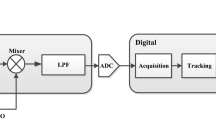Abstract
Stability, which is significantly related to the loop parameters, is an important factor in the traditional GPS tracking loop design. Through the analysis of phase margin values in the discrete GPS PLL tacking loop, we are able to theoretically reveal the relationship between loop stability, equivalent noise bandwidth B n , predetection integration time T, and loop parameters. We calculate the theoretical limitations for B n T, that is, the product of equivalent noise bandwidth multiplied by predetection integration time, for second- and third-order phase-locked loop, respectively. The results are verified by actual data from GPS receivers.











Similar content being viewed by others
References
Astrom KJ, Hagglund T (1995) PID controller: theory, design, and tuning, 2nd edn. The Instrumentation, Systems, and Automation Society
Ba X, Liu H, Zheng R, Chen J (2009) A novel algorithm based on FFT for ultra high-sensitivity GPS tracking. In: Proceedings of ION GNSS 2009. Savannah, GA, United states, pp 339–345
Freijedo FD, Doval-Gandoy J, Lopez O, Cabaleiro J (2008) Robust phase locked loops optimized for DSP implementation in power quality applications. In: 34th annual conference of IEEE industrial electronics (IECON 2008), pp 3052–3057
Garder FM (2005) Phaselock techniques, 3rd edn. Wiley, New York
Gupta S (1968) On optimum digital phase-locked loops. IEEE Trans Commun Technol 16(2):340–344
Humphreys TE, Psiaki ML, Kintner Jr. PM, Ledvina BM (2005) GPS carrier tracking loop performance in the presence of ionospheric scintillations. In: Proceedings of ION GNSS 2005, Long Beach, CA, pp 156–167
Jin T, Wang Y, Lv W (2012) Study of mean time to lose lock and lock detector threshold in GPS carrier tracking loops. Chin J Electron (submitted)
John PC, Brian MF (2006) A 27 GHZ phase-lock loop phase detector. In: Canadian conference on electrical and computer engineering (CCECE ‘06), pp 1506–1509
Kazemi PL (2008) Optimum digital filters for GNSS tracking loops. In: Proceedings ION GNSS 2008, Savannah, GA, pp 2304–2313
Kishine K, Fujimoto K, Kusanagi S, Ichino H (2004) PLL design technique by a loop-trajectory analysis taking decision-circuit phase margin into account for over-10-Gb/s clock and data recovery circuits. IEEE J Solid-State Circuits 39(5):740–750
Lindsey WC, Chak MC (1981) A survey of digital phase-locked loops. Proc IEEE 69(4):410–431
Progri IF, Kelley CW, Gao G, Michalson WR, Wang J, Lavrakas J (2007) Discrete vs. continuous carrier tracking loop theory, implementation, and testing with large BnT. In: Proceedings ION GNSS 2007, Fort Worth, TX, pp 2584–2610
Spilker JJ (1996) Fundamentals of signal tracking theory. In: Parkinson BW, Spilker JJ (eds) Global positioning system: theory and applications, vol I, American Institute of Aeronautics and Astronautics, Inc, USA, pp 245–328
Stephens DR (2001) Phase-locked loops for wireless communication: digital, analog and optical implementations, 2nd edn. Springer, Berlin
Stephens SA, Thomas JB (1995) Controlled-root formulation for digital phase-locked loops. IEEE Trans Aerosp Electron Syst 31(1):78–95
Thompson IV, Brennan PV (2005) Fourth-order PLL loop filter design technique with invariant natural frequency and phase margin. IEE Proc Circuits Devices Syst 152(2):103–108
Tsui JB (2000) Fundamentals of global positioning system receivers: a software approach. Wiley, New York
Ugarte M, Carlosena A (2010) High-order PLL design with constant phase margin. In: 53rd IEEE international midwest symposium on circuits and systems (MWSCAS 2010), pp 570–573
Ward PW (1996) Satellite signal acquisition and tracking. In: Kaplan ED (ed) Understanding GPS principles and applications, 1st edn, pp 110–208. Artech House, Inc, Norwood, MA
Ward PW, Betz JW, Hegarty CJ (2006) Satellite signal acquisition, tracking, and data demodulation. In: Kaplan ED, Hegarty CJ (ed) Understanding GPS principles and applications, 2nd edn, pp 153–241. Artech House, Inc., Norwood, MA
Weinfeld D, Bar-David I (1995) Phase locked loop with extended range phase detector. In: Eighteenth convention of electrical and electronics engineers in Israel, 1995, pp 1–4
Yaniv O, Raphaeli D (2001) Near-optimal PLL design for decision-feedback carrier and timing recovery. IEEE Trans Commun 49(9):1669–1678
Zhuang W (1996) Performance analysis of GPS carrier phase observable. IEEE Trans Aerosp Electron Syst 32(2):754–767
Zhuang W, Tranquilla J (1995) Modeling and analysis for the GPS pseudo-range observable. IEEE Trans Aerosp Electron Syst 31(2):739–751
Acknowledgments
This work was supported in part by National Science Foundation of China under Grant Number 61101076. We thank Dr. Phillip Ward for the valuable suggestions that very much improved the manuscript.
Author information
Authors and Affiliations
Corresponding author
Appendix: PM solution in third-order tracking loop
Appendix: PM solution in third-order tracking loop
For the general cubic equation \( ax^{3} + bx^{2} + cx + d = 0 \), there are three roots,
Where \( Q = \sqrt {\left( {2b^{3} - 9abc + 27a^{2} d} \right)^{2} - 4\left( {b^{2} - 3ac} \right)^{3} } \) and \( C = \root{3} \of {{\frac{1}{2}\left( {Q + 2b^{3} - 9abc + 27a^{2} d} \right)}} \). Assuming x is the \( \cos \omega_{p} \) in cubic equation (25), the coefficients a, b, c, d can be represented by
Because the phase margin \( (\cos \omega ) \) is a real number, only real root x 1 can be used when solving cubic equation (25). Thus, we get
and
Substituting loop coefficients G 1, G 2, G 3 and prediction integration time T into (24), (34) and (36), the phase margin figure of third-order loop can be drawn as Fig. 7.
Rights and permissions
About this article
Cite this article
Jin, T., Ren, J. Stability analysis of GPS carrier tracking loops by phase margin approach. GPS Solut 17, 423–431 (2013). https://doi.org/10.1007/s10291-012-0290-8
Received:
Accepted:
Published:
Issue Date:
DOI: https://doi.org/10.1007/s10291-012-0290-8




